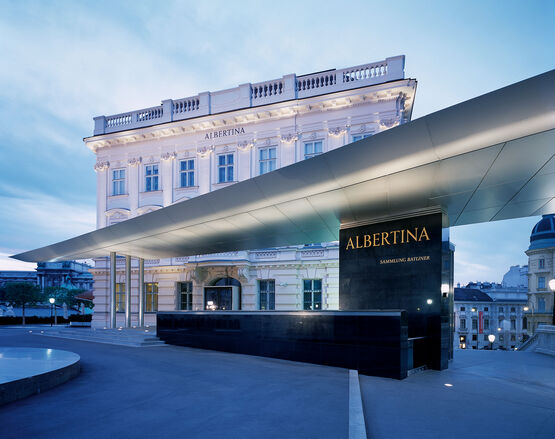In a modern society there is always a fire risk. A fire detection system ensures that nothing is left to chance if there is imminent danger. Works of art that make it onto the walls of museums are usually unique. They are irreplaceable as cultural assets of inestimable value and must be protected from anything that could endanger their integrity. After all, it is easy for a fire to cause irreversible damage or even a total loss if no safety precautions are taken. The Labor Strauss Group sees its core competence in the protection of people and property and has been supporting the fire protection of the whole museum operation of the ALBERTINA for more than 20 years.
Installation of fire protection devices with flexible coordination
According to well-informed sources, the ALBERTINA looks back at an exciting building history. Bear in mind that the guidelines for the protection of historic buildings and monuments and the cultural heritage restrict what can be done. The sales engineer Herbert Pflügl, who is responsible for sales and customer care at LST, can confirm this. When he thinks back to the conversion phase, which dates back to 2003, he describes the challenges of the project in just one sentence: "Harmonising the numerous targets was not always easy, but solvable." Translated from engineering-speak into plain language this means, the ideas of all those involved – from architects to the museum curators – have to be reconciled so that they correspond technically and visually to the specifications for the general renovation. In the case of the latter, it should be noted that the fire detection of the rooms should remain aesthetically unobtrusive. Another factor that is very important is the ease of maintenance of the installed equipment, which must not be compromised under any circumstances. "If, for example, smoke aspiration detectors are installed behind panelling or wallpaper, they still have to remain accessible," he says, hinting at the professional art of implementing a comprehensive fire protection concept in a museum in an architecturally correct manner.
Data & Facts
Line of business: culture
Protected Building: Museum
Beginning of partnership: 2001
Total protected area: 28.000 m²
Line length: 50.000 metres
Number of fire detectors: 900
- 650 punctual fire detectors
- approx. 100 special detectors (smoke aspiration systems, beam detectors, etc.)
- 130 sounders
- 90 manual call points
- 80 fire controls (lifts, ventilation, activation of smoke escapes)
Clemens Strauß, the ALBERTINA's Head of Facility Management, leads through the halls of the museum which houses Dürer's Young Hare, Monet's Water Lily Pond as well as many masterpieces of further art history giants. "Of course, the question arises as to how the fire protection components fit the design of the exposition areas. Nevertheless, the safety of visitors, employees and exhibits is the top priority." The Fire Detection Control Panel Series BC600 is accommodated in the monitoring station on the ground floor of the ALBERTINA. The heart of the system has the task of collecting and processing information from the connected fire detectors, detecting risks and producing optical and acoustic signals. In this way, mechanisms are initiated that guarantee comprehensive protection of the entire area at all times.
To allow the system to work perfectly, there are five more sectional control panels in the ALBERTINA, which are distributed in equipment shafts within the building complex. The structure is modular, can be adapted to changed parameters and allows almost limitless expansion.
Special detectors
In addition to the classic detector of automatic fire detection systems, the punctual fire detector, which is fitted to the ceilings of many public rooms, there is also the group of special detectors. They are particularly suitable for museums with outstanding architectural features and a large number of visitors and are positioned and programmed in such a way that they can detect a fire even in the smouldering phase. "Optimal detection of fire danger is achieved if a fire is detected before it becomes visible to the naked eye. As a result, the firefighting can be initiated before the fire brigade arrives," Herbert Pflügl says, explaining the basic idea of the special detectors. Smoke aspiration systems: Via the pipe network, air is sampled from the monitored room and directed to a detector module, which analyses the air samples and identifies barely visible smoke particles. If the concentration of smoke exceeds the permissible value, this information is transmitted to the fire detection control panel. Light barrier smoke detectors consist of a transmitter/receiver unit and a reflector. These are mounted on opposite walls at a distance of five to seventy metres. An infrared light beam is projected by the transmitter/receiver unit through the area to be protected towards the reflector, which returns the light beam. Smoke detection is based on the attenuation of the light beam's intensity that is caused by clouded or flickering air, which triggers a fire alarm in an emergency. "This type of smoke detector is often used in large rooms with high ceilings, because it only requires minimal wiring," says the ALBERTINA fire prevention officer, summing up the advantages of the various systems. "In the case of highly flammable cultural treasures made of paper and wood, the performance of automatic fire detection and firefighting is not up for discussion. Every second of the reaction time counts, and here the expandable fire detection control panel also comes into play," Herbert Pflügl remarks. The fire protection concept is completed by further measures such as fire doors, which separate building sections from each other and limit smoke and fire to the location of the incident.
LST technicians carry out annual maintenance and, if necessary, repairs to ensure that the protection of people and buildings is always maintained at the highest level. Thanks to the remote access system REACT, the indication of the system events and the operation of the fire detection system through a PC, a tablet or a smartphone is possible everywhere in real time – provided that Internet access is available. The ALBERTINA also relies on LST's expertise when it comes to servicing: On site, around the clock and even digitally.
Press release as PDF for download
Information for inquiries by the press:
comm:unications – Consulting & Services
Sabine Pöhacker & Irene Maurer, Tel. 0043 1 315 14 11-48
Wasagasse 6/6, A -1090 Wien
irene.maurer@communications.co.at
www.communications.co.at











